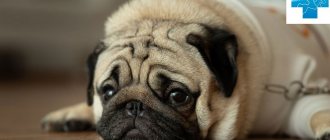Diarrhea, or simply diarrhea, is not a rare occurrence in dogs. As in humans, diarrhea comes suddenly and radically changes the usual state. This disease brings inconvenience not only to the dog, but also to humans. After all, diarrhea can be complicated by other serious accompanying symptoms, such as vomiting. And prolonged diarrhea can even lead to death.
In this article we will analyze in detail why blood appears in feces and what their color depends on. Let's look at the diseases that can cause this symptom. We will also tell you how to provide first aid and cure a pet with such a delicate illness.
What is diarrhea and its types
Diarrhea is the passage of stool in liquid, semi-liquid or unformed form.
Diarrhea - this process is not a disease and certainly cannot be diagnosed; it is just a symptom of a disease or gastrointestinal disorder.
In veterinary medicine, it is considered as a pathological condition, primarily signaling a disorder of the gastrointestinal tract. But gastrointestinal diseases are not always the cause of diarrhea; there is a wide range of diseases and causes that can cause diarrhea.
In veterinary practice, depending on the duration, there are two types of diarrhea: acute and chronic.
Acute diarrhea
It is characterized by a sharp and sudden onset and lasts no more than 3–4 days.
The main reasons are mechanical damage to the gastrointestinal tract, a foreign body in the intestinal lumen, intoxication (poisoning with any unsuitable food products), various diseases of infectious etiology.
The danger of acute diarrhea should be judged based on the cause that causes it. In most cases, with proper and timely treatment, the pet’s health is not in danger.
Chronic diarrhea
It is characterized by a long course, more than a week.
The causes of this pathology may be: infectious diseases, intoxication of the body due to the prolonged action of some factor on the body, and much more.
If chronic diarrhea is not prevented in a timely manner, serious fears for the pet’s life may arise, in which dehydration (large loss of water), disturbance of water-electrolyte balance and disturbance of acid-base metabolism, lack of vitamins and minerals, and the appearance of hemorrhoids are observed.
Without proper care, the animal may die from dehydration.
A symptom such as diarrhea in itself does not pose a danger to the animal, but if chronic, it can be dangerous to the pet’s health.
Causes and symptoms
To eliminate diarrhea, you need to know the reason that caused it. After all, the method of treatment, prevention and nutrition of the animal will depend on this. We have identified a number of the most common reasons:
Feeding disorders – this may include:
- sudden change of food, which is especially sensitive for dogs with digestive problems;
- low-quality food products (spoiled dairy products, meat products, etc.);
- eating inedible things/substances (leads to intestinal blockage);
- fatty food.
Parasites are the most common cause of acute diarrhea in puppies. Worms are the most common parasitic form.
Bacterial infection (with secreted toxins) - these include salmonella, clostridia, campylobacter, E. coli and others. Infection occurs through ingestion of products containing the above bacteria, with contaminated water, food and feces of sick animals.
Viral infections - cause diseases such as parvovirus enteritis, coronavirus, canine distemper (distemper), rotavirus infection, adenovirus and other diseases of viral etiology can cause diarrhea.
Fungal infections and protozoa are often the “culprits” of loose stools.
Medicinal substances – long-term use of antibiotics can lead to digestive upset. Toxic substances - acaricides and poisons can lead to diarrhea.
Disturbance of metabolic processes in the body.
Allergic reactions to anything, in particular to the components of a new food.
Obstruction of the digestive tract , including those caused by intussusception (invasion of one section of the intestine into another).
Diseases of non-infectious etiology (pancreatitis, GTE - hemorrhagic gastoenteritis, tumors of the gastrointestinal tract, etc.).
If a person has encountered such a problem as diarrhea at least once, then he knows its symptoms. There are no special symptoms for dogs and other animals; they are the same for everyone.
What should alert the owner in order to make a diagnosis of diarrhea:
- change in the state of feces (liquid/semi-liquid, color, smell, impurities);
- frequency of going to the toilet (more than 3–4 times a day) and volume of feces;
- pain during defecation, uncharacteristic posture;
- flatulence (intestinal gases - the stomach constantly “rumbles”);
- indigestion;
- fever (increased body temperature);
- lack of appetite, exhaustion.
Diarrhea with blood
This is a serious problem that requires immediate attention.
We strongly advise you not to self-medicate, since only qualified doctors can identify the causes of bleeding.
First, let's look at the reasons why blood may appear in the stool:
Damage to the intestinal walls, both mechanically (sharp objects, gnawed bones, etc.) and through pancreatitis, stomach ulcers, enteritis, damage to the liver and bile ducts - this is a small part of the possible appearance of blood in the stool.
You can differentiate where the blood comes from by its color - dark blood indicates it came from the stomach or small intestine, red blood indicates bleeding from the large intestine (blind or colon), scarlet blood - directly from the rectum.
Mucus is often added to bloody diarrhea, often indicating the presence of helminths, or inflammatory processes or mechanical damage.
Treatment of such diarrhea will be aimed at eliminating the causes of bleeding. After stopping the bleeding, wound-healing drugs are prescribed to prevent the development of septic and inflammatory processes. The stomach is washed and, if necessary, antibiotic therapy is prescribed.
Bloody diarrhea and vomiting
Sometimes diarrhea can be complicated by vomiting. We can say that there are twice as many problems. It is necessary to monitor the dog; if this is an isolated case, then there is no cause for concern, but if this happens with enviable regularity, you should contact a veterinarian.
Causes of vomiting:
- overeating - due to the inability of the stomach to digest a large amount of food;
- foreign body - then the vomit will contain foamy mass or bile;
- helminths;
- fatty or difficult to digest foods;
- poisoning with food or toxic substances;
- viral and infectious diseases.
Vomit may contain digested/undigested food, mucus, blood, bile, foam.
Treatment begins with eliminating the factor causing vomiting. Since the animal loses a lot of water, it is necessary to frequently give it water or use water-salt solutions.
Reduce feeding, or better yet, put the dog on a starvation diet (for 1 day). Sorbents are used and, if necessary, painkillers. If there is repeated vomiting and diarrhea, a diagnosis is made, and depending on the diagnosis, the doctor prescribes treatment.
Diarrhea without other symptoms
Diarrhea without complications is a good sign for both the dog and its owner. After all, the cause of such a disorder in most cases is not serious and can be easily corrected.
The main reasons are:
- spoiled product;
- a sharp transition from wet food to dry food (causes stress on the stomach, so sometimes diarrhea is observed after dry food);
- fatty and difficult to digest foods;
- allergy;
- foreign object in the gastrointestinal tract;
- helminthic diseases (diarrhea can be observed not only during the presence of worms in the dog, but also after deworming).
Treatment consists of finding and eliminating the cause. For prolonged diarrhea, adsorbents are given and deworming is carried out (worming). Reduce the amount of food and give a large amount of water. Antibiotics are prescribed if necessary.
Cough and nasal discharge - snot with diarrhea, occurs due to a foreign object in the gastrointestinal tract or due to concomitant diseases.
Diarrhea in pregnant bitches
Isolated cases of diarrhea in a pregnant or lactating bitch are a common occurrence and not something to worry about too much.
The cause of diarrhea in a pregnant dog is changes in the body that occur due to hormones. In general, the body is reconstructed; if previously the quantity and quality of food was suitable for the dog, with the onset of pregnancy this can change dramatically.
It is also possible that such a phenomenon as toxicosis may occur.
After childbirth, diarrhea may also occur; if it is isolated, then there is no need to worry. This is facilitated by the formation of milk in the mammary gland (this process requires a large amount of vitamins, macro- and microelements) and hormonal changes.
No special treatment is required, you need to monitor the condition and give more water. Treat as for normal diarrhea in non-pregnant dogs.
With diarrhea, trembling may appear - this is a serious symptom that requires immediate consultation with a doctor; trembling appears with severe dehydration and a lack of micro- and macroelements, which is life-threatening.
How is the diagnosis carried out?
The first stage on the path to effectively eliminating the existing problem is a correctly performed diagnosis, the methods of which are determined by the veterinarian after a visual examination of the animal and collection of anamnesis.
From laboratory tests, the most common when bloody diarrhea appears are the following:
- A general blood test, the results of which will help confirm or refute posthemorrhagic anemia, neutrophilic or lymphocytic leukocytosis and increased erythrocyte sedimentation rate. All this will help to find out about the presence of infection and inflammatory process in the body.
- Blood chemistry. With its help, a study of the renal and hepatic complex of elements is carried out, primarily creatinine, urea, liver enzymes ALT and AST.
- Stool analysis to determine helminth eggs or adult parasites.
- Virological blood test, enzyme immunoassay or polymerase chain reaction, designed to determine the causative agent of the infectious process in the body.
- Instrumental research methods will be a little more informative in determining the specific cause of the appearance of blood in the stool, in particular:
- Gastroscopy and colonoscopy (endoscopic group studies), which help determine the specific source of bleeding, in particular when cancer is suspected.
- X-ray examination (contrast or plain X-ray). Like the previous method, it helps to accurately determine the location of the lesion.
- Ultrasound examination of the abdominal organs. Using appropriate equipment, the doctor can assess the condition of all internal organs and determine the presence of free fluid in the abdominal cavity.
Did you know? The most famous fat dog, included in the Guinness Book of Records, is a border collie named Cassie. At the age of 7 years, she weighed 58 kg, while the norm for representatives of this breed is considered to be no more than 22.5 kg.
The results of several studies together help to create a holistic picture of what is happening and select the most optimal treatment for each individual dog, taking into account the concomitant diseases found in it.
What determines the color of diarrhea?
The color of feces can vary significantly from light yellow to black. This depends on many factors - the presence of blood, pigments, food eaten, medications, the condition of organs and much more. Let us analyze and describe each type (color) of feces and its probable causes of occurrence.
Yellow
Appears with indigestion, liver diseases, blockage of the bile ducts, hepatic jaundice and more, the main reason is the rapid movement of bile pigment - bilirubin through the intestines, which does not have time to transform into the usual brown color.
Orange
Indicates diseases of the gallbladder, biliary tract and liver.
Black
Appears when there is bleeding in the stomach or small intestine, as well as when feeding activated charcoal to an animal.
Green
Indicates rotting of the intestinal contents (with subsequent absorption of rotting products into the blood), dysbiosis, viral and bacterial infections, and the dog eating green plants and vegetables.
Red
Caused by bleeding or damage to the wall of the large intestine or severe inflammation in it.
Dark brown
Normally, feces have different shades of brown, they depend on the food that is given to the animal.
Grey
Signals the presence of parasites in the body, also found in parvovirus enteritis.
White
Indicates complete blockage of the biliary tract.
Green vomit with diarrhea
Indicates intestinal obstruction as bile and intestinal contents enter the stomach.
Why vomiting
In episodes of diarrhea, it is often accompanied by vomiting. Together, these symptoms occur in many diseases, the nature of which can be described as either infectious or non-infectious. Sometimes this is simple poisoning, but if these symptoms appear in puppies, this is a clear sign of a viral infection.
Let's consider several common diseases that are accompanied by joint vomiting and diarrhea:
- Parvovirus enteritis does not occur in dogs older than one and a half years. Characterized by low temperature, refusal of food and water. The disease progresses quickly and has a high mortality rate.
- Infectious hepatitis develops over 2 weeks and occurs in animals of any age. On examination, he is characterized by an enlarged liver.
- Coronavirus enteritis, you are dealing with it if the dog’s temperature remains above normal for a long time (39 ° C).
There are also dogs that have diarrhea and vomiting regularly, without other symptoms of illness. Doctors confirm that some dogs have this feature of their physiology, inherited from ancestors who were predators.
Treatment
What to do first?
First of all, try to find out or remember the possible cause of diarrhea - stale meat/fish, sour dairy products, and eliminate this from the diet.
Monitor the condition of the dog and the excreted feces (note color, quantity, smell, impurities). If you overeat, reduce the portion of food.
If the reason is different, put the dog on a starvation diet (1 day) with mandatory water (preferably boiled) and activated carbon (1 tablet/10 kg). Afterwards, consult a doctor to avoid sad consequences.
Diagnostics
To make a diagnosis, the doctor needs to collect an anamnesis, the owner needs to describe in as much detail as possible what exactly happened to the dog.
How many days does the diarrhea last, what color is it, the smell, the presence of any impurities, tell in detail the dog’s diet for the last 3 to 4 days.
Have you had any vaccinations? The month when deworming was carried out. Has the animal been in contact with sick dogs?
After collecting anamnesis, the doctor will prescribe a stool test for the presence of parasites and occult blood, and a general urine and blood test. At the discretion of the doctor, the animal may be sent for x-rays to identify any blockage or foreign body in the intestine.
Diarrhea medicine for dogs
Medicines used for humans are suitable for treating diarrhea in dogs.
Activated carbon, enterosgel, smecta, enterofuril, furadolizole, loperamizh, chloramphenicol, etc.
Special veterinary drugs: Panacur, Enterozoo, Vetom 1.1 and others on the recommendation of a doctor.
Antibiotics, anti-inflammatory - as prescribed by a veterinarian.
Treatment at home
- the first thing to do in case of diarrhea is a starvation diet (1-2 days);
- changing your diet, eliminating fatty and hard-to-digest foods;
- drinking plenty of boiled water;
- the use of medications - adsorbents can be done independently, others - as prescribed by a doctor;
- peace and comfortable living conditions.
Helminths can cause not only diarrhea, but also often constipation.
Is it possible to give medications?
The veterinarian you contact for help should prescribe medications. To choose therapy, the doctor needs to familiarize himself with the test results, and the selection of medications becomes a matter of individual cases. At home, it is better to limit yourself to a diet and, perhaps, a couple of tablets of activated carbon dissolved in water.
At the clinic, they will almost always provide you with anti-worm tablets first. Then your pet will have an IV installed. The solution entering the animal’s blood will have several effects at once: against infection, against inflammation. The tablets will resist inflammation in a less aggressive form. Critical cases will require antibiotics.
Prevention
- Do not allow the animal to eat inedible food, expired/spoiled products, do not allow the dog to “pick up” anything on the street, especially in trash cans.
- Vaccinate and vaccinate the animal in a timely manner.
- Give antibiotics and other drugs that cause diarrhea only under the supervision of a specialist.
- Monitor your general condition.
- Provide your four-legged dog with a complete, balanced diet.
Feeding a dog with diarrhea
On the first day, it is recommended not to feed the pet at all, but to put it on a starvation diet. If the dog shows interest in food, you can give a small amount of boiled rice. In this case, it is necessary to give a large amount of boiled water. Feed in small portions.
On the second - fourth day, it is allowed to feed the animal with fermented milk products, this helps to normalize the intestinal microflora. Lean boiled meat, preferably chicken.
You can use food from a line that helps treat gastrointestinal diseases.
Sometimes owners do not change the diet during diarrhea, as the pet still has a good appetite. This should not be done; in order to get rid of diarrhea, an integrated approach is needed.
Feeding rules
When you notice liquid discharge from your dog, stop feeding it. It is advisable to leave the dog without a feeder for at least a day. Give only water, and plenty of it, to combat dehydration.
After a hungry day, give your pet a decoction of rice or rice itself, only well-cooked. To normalize the intestinal microflora, fermented milk products are good. As a remedy for diarrhea, some recommend black tea, only weak, with added sugar. You need to save such a menu for at least a couple of days and make sure that the disease recedes.
Once the diarrhea has stopped, you should plan your pet's menu for a few weeks to avoid heavy or fatty foods. The best choices are broths, rice porridge and fermented milk products.
Prolonged diarrhea will indicate a serious illness. Here you need to immediately run to the doctor. As in cases where your pet refuses to eat and drink with diarrhea, has a high fever, vomiting, coughing with snot and tears.
FAQ
How to treat diarrhea in puppies?
Diarrhea in puppies is treated in exactly the same way as in adult dogs, the only significant difference will be the duration of the fasting diet - a maximum of 10 - 12 hours.
Is it possible to give a dog “human” drugs: chloramphenicol, imodium, activated carbon, loperamide, smecta, furazolidone, enterofuril, polysorb, lopedium for diarrhea?
It is possible, but you should consult your doctor before use. Since each organism is individual and requires its own approach.
Briefly about the main thing
- Diarrhea, also known as diarrhea, is a symptom and not a separate disease.
- Chronic diarrhea is more dangerous because... may lead to death.
- If blood appears in the stool, contact your veterinarian immediately.
- Vomiting in symbiosis with diarrhea leads to severe dehydration; without timely assistance, the animal will die.
- The color of feces indicates pathological changes in organs.
- Treatment is carried out comprehensively, sometimes with a course of antibiotics.
- Nutrition during diarrhea is special, with plenty of water and a minimum amount of food.
What are the dangers of loose stool mixed with blood?
Any disorder in a dog’s body should alert its owner, especially if it is accompanied by the appearance of blood and a general depressed state of the pet. Bloody diarrhea is often a sign of a malignant tumor or a foreign body stuck in the intestine, which means that the sooner the operation is performed, the greater the dog’s chances of continuing to live. Viral and infectious diseases can also be fatal, so do not underestimate them either.
A deterioration in well-being and a change in normal behavior against the background of the possible death of a pet does not seem so dangerous, but do not forget that the animal should live a full life and not suffer from pain.











